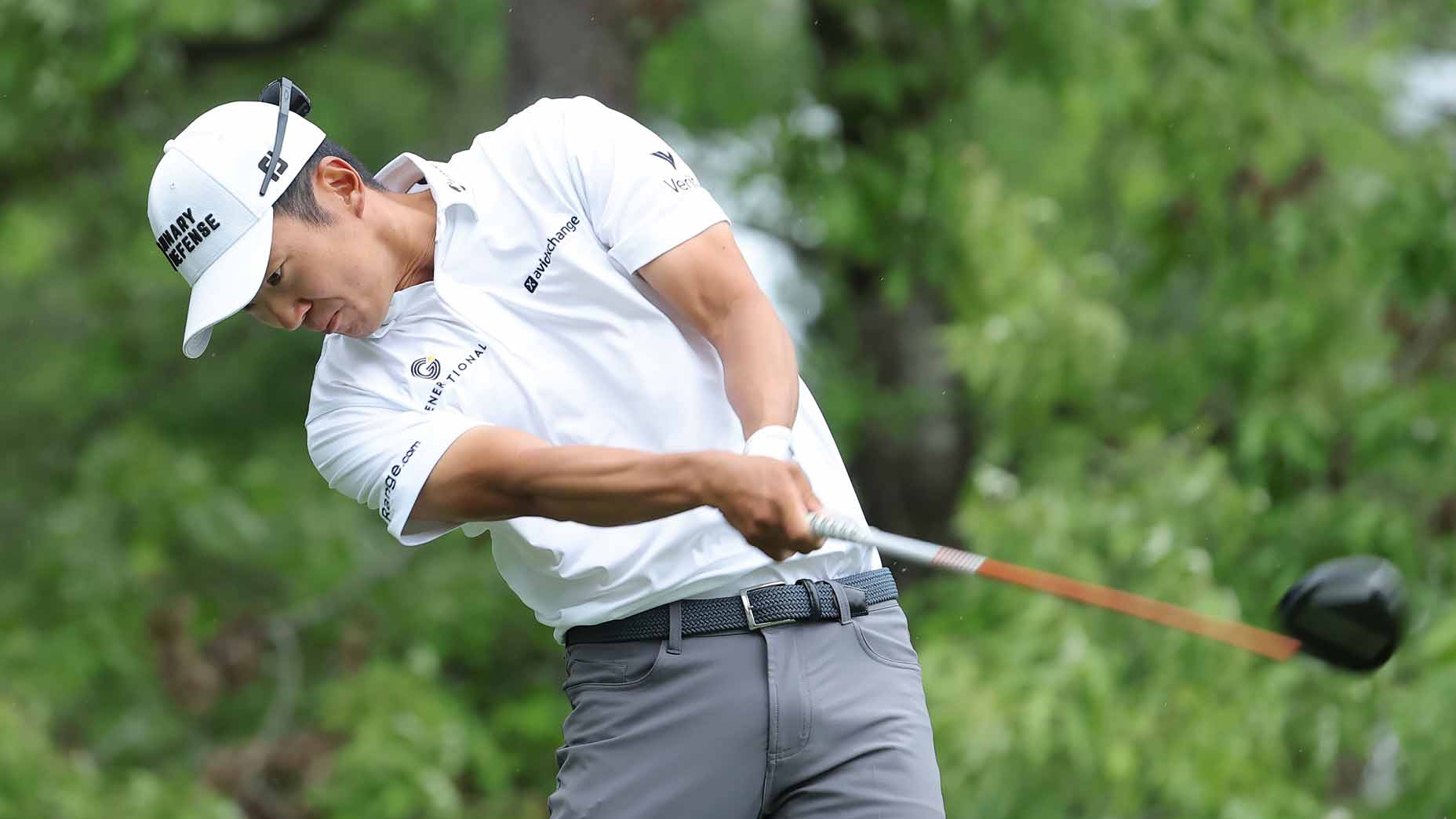This is the first installment of our seven-part The Modern Pro series, in which GOLF.com will break down every aspect of the elite professional golfer in 2018, including their money, fitness routines, lifestyle, and, as you can read below, swings.
———————————–
When his son began knocking tee shots high and straight at age 3, Mike Thomas had a hunch he might raise a gifted golfer. By age 5, the boy could hit cuts and draws on cue. But when young Justin Thomas reached the junior golf circuit, his game had one glaring weakness:
Power. JT was unable to keep up with his peers.
“He couldn’t hit it anywhere,” says Mike, the longtime PGA professional at Harmony Landing CC in Goshen, Ky., who has coached his son since Day 1. “He’d call me from AJGA tournaments after a practice round and just give me a number, let’s say it was 6. That would be the number of holes he couldn’t reach in regulation.”
Eventually, the skinny kid from Kentucky would blow it past his fellow competitors. His dad says there was no “aha” moment. No single grip adjustment, setup move, or shoulder turn that resulted in a burst of extra yardage. The evolution of what would become arguably golf’s most efficient swing — at 5-foot-10-inches, 150 pounds, Thomas ranked 8th in driving distance last season on Tour at 309 yards per pop — started with Thomas doing the same thing any young golfer would do when their buddies regularly bombed it past them.
“He grew up swinging as hard as he could,” Mike says. “That became his nature.”
Justin also developed tremendous hand-eye coordination (plus a killer short game), which allowed him to consistently hit the ball on the sweet spot. As he moved from an elite junior golfer to a collegiate freshman at Alabama, the evolution of Justin Thomas, power player, began to accelerate.
One day during his freshman year, Justin and his father visited a friend on a driving range in Bowling Green, Ky., where they sampled a new piece of technology: Trackman, the electronic monitor that on each shot can measure everything from carry distance and launch angle to ball speed and spin rate. “We’re old school,” Mike says. “We’d been doing it with video and feel.” On that first Trackman session, father and son saw the raw distance that could be attained when Justin focused on his angle at impact. He possessed the ability to hit up on the ball consistently at a 4- or 5-degree angle, while the Tour average is about negative 1. The added launch began to pay dividends.
“We moved the ball up more in his stance, and it maximized everything he was doing,” Mike says. “It’s probably something we would’ve gotten to eventually. With Trackman, you can just move something, take a few swings, and see the changes.”
The addition of Trackman to Thomas’s solid fundamentals, natural gifts and lifelong habit of swinging full-bore eventually produced a winner. Thomas won his 39th Tour start as a professional, and there is no course on earth he can’t handle. Gone are the forlorn phone calls to dad. Today, at age 24, Thomas is a major champion and freshly minted PGA Tour Player of the Year.
Thomas’s own progression is symbolic of the progression of the swing at large. Thanks to young bombers like Rory McIlroy, Jason Day, Dustin Johnson and Brooks Koepka among others, hitting it hard has never looked better, or been more lucrative. Today’s junior golfers are watching the gun show the same way Thomas once studied Tiger Woods, and they want in. And so we arrive at the core of modern swing philosophy: max out whatever you’ve got.
“These little guys that are jacking it are just so unbelievably efficient mechanically — they’re able to get everything they can on every swing,” says Brady Riggs, a GOLF Top 100 teacher who coaches Brandon Hagy, whose 312.7-yard average off the tee ranked third on Tour last year behind McIlroy and DJ. “There was a time when swinging past parallel was anathema. Now they’re opening it up again. The length of the backswing doesn’t matter.”
[image:14020863]
The emphasis on distance begins long before an aspiring pro earns his Tour card. Riggs notes that the venues staging elite college tournaments are also being stretched to lengths once unheard-of. (For example, the 2017 Men’s NCAA Championship at Rich Harvest Farms, outside Chicago, featured a tree-lined course that played 7,300 yards with juicy rough.) To hang at the elite level, young golfers have little choice but to master the long ball. “Those premier schools with top scholarships won’t recruit someone who can’t kill it,” Riggs says.
That affects how instructors teach their students. Riggs cites Nick Faldo as an early influence on both his swing and his teaching lessons. Sir Nick, at a sturdy 6-foot-3, used a compact swing to play ruthlessly controlled golf while winning six majors. “I loved the geometry, the lines of his swing, and also the lack of aggression — it was so clean,” Riggs says. “But I think that has been found to be less effective than letting guys open it up. Now guys are trying to hit it really hard and not worry about how accurate it is, and then they rein it in as time goes on.” Here’s a closer look at a swing that is now more or less passé.
Brandel Chamblee, the former Tour pro-turned-Golf Channel analyst, estimates that pros today are about 40 yards longer than in 1980, with the bulk of the yardage stemming from improvements in ball and club technology, plus better course conditions that amplify rollout. He cites Thomas as a textbook example of how any player can employ modern technology to add yards.
“The idea that Justin swings really fast isn’t true,” Chamblee says. “He swings 116 miles an hour, and the Tour average is 113. He hits it so far because he’s able to minimize spin and maximize launch. He’s really the perfect example of what players can do today by maximizing fit and technology.”
Chamblee is particularly fond of Thomas’s downswing, where he pushes with the ball of his right foot for full extension and rotation that results in that swinging-out-of-his shoes finish. Chamblee deemed it “a wonderful and powerful move,” and one that was reminiscent of Tiger Woods in his heyday. When you put JT’s follow-through against Woods circa 1999, the similarity is indeed striking — pun intended.
[image:14020862]
In researching his 2016 book, The Anatomy of Greatness, which explores the swings of the game’s all-time greats, Chamblee noticed a pattern among the overwhelming majority of the game’s best, including Jack Nicklaus, Arnold Palmer and Tom Watson: During their backswing, they would lift their left heels slightly off the turf (if they swung right-handed), creating more flexibility for a wider shoulder turn, which then generated a faster downswing. Chamblee also found more great players had “upright” swings, where the path of the club is more vertical, instead of “flat,” or around the body. In addition to Thomas, Chamblee cites Jordan Spieth, Dustin Johnson and Jason Day among the current crop who currently employ this type of action. The move’s benefits, he says, are apparent.
“They typically hit the ball higher and longer,” Chamblee says. “Imagine a hula-hoop. If you put it on an upright plane it’ll go higher. It also requires less maintenance. Flat-swingers, like Ben Hogan or Gary Player, often required more practice.”
Chamblee says that golfers with flat swings and limited hip turns produce tension throughout their bodies, including in the abs, back and thighs. That rigidity can create an explosive transition, but there are risks. “The body isn’t built like a spring, so it makes a player more susceptible to injury,” he says. “That’s why I think we’re seeing a rash of back injuries among players in their 20s and 30s that I would argue is unprecedented in golf.”
Physical damage remains a cloud hanging over many of these powerful young players. McIlroy, at 28, missed several weeks last season with a rib injury. Day, who recently turned 30, has battled a balky back. Woods’s catalogue of surgeries is well chronicled. It all begs the question: Are Thomas and his hard-swinging peers built to last?
“I think time will tell. Anybody who swings as hard as they can, over time, is asking a lot of themselves,” Riggs says. “I don’t know if longevity is the goal for these guys. There’s so much money so early, I don’t know if they want to play 25 or 30 years. It’s an open question.”
“No question, that’s a concern,” Mike Thomas adds. “We put that trust in the people who are working with [Justin] on his body and fitness, and that this team will create a plan and a body that will hold up.”
That body and swing just produced one of the greatest seasons since Tiger in his prime. The skinny kid from Kentucky will now try to do it all over again, just as he did it last year: by letting it rip.







